#butchulla
Text

Butchulla woman, Shazharna Anmanari Brown'x, Australia, by Trent White
#butchulla#australia#oceania#folk clothing#traditional clothing#traditional fashion#cultural clothing
353 notes
·
View notes
Audio
Yirinda beautifully interweaves Butchulla tradition with modern production and classical instrumentation. The resonant melodies crafted by the duo carry thousands of years of stories and culture, yet they also ascend into new.
0 notes
Text
The people of K'gari were known to be kind to shipwrecked mariners, but a few months after the raid they treated the survivors of the wreck of the Thomas King with unusual barbarity. William Henry Walsh put it down to a fresh spirit of revenge among the Butchulla.
Frequent allusions have been made to the extraordinary secresy of the result of that jaunt, and much surprise expressed at the profound silence maintained concerning their exploits, by this most heterogenous body of black hunters. True, now and then we receive little bits of information from Sydney, (of all places in the world), that rumours are afloat that the natives were driven into the sea, end there kept as long as daylight or life lasted.
"Killing for Country: A Family History" - David Marr
#book quotes#killing for country#david marr#nonfiction#k'gari#fraser island#qld#queensland#australia#butchulla#indigenous australians#aboriginal australian#kindness#shipwrecked#mariners#survivors#thomas king#barque#william henry walsh#revenge#eora#sydney#news
0 notes
Text
One morning Bidwill found a black carrying off his flowerpots.
"Killing for Country: A Family History" - David Marr
#book quote#killing for country#david marr#nonfiction#john bidwill#butchulla#indigenous australians#aboriginal australian#flower pots
0 notes
Text
K’Gari, formally Fraser Island, officially renamed by Australian Government.
K’Gari is the original placename for the largest sand island in the world. After Captain James Fraser and his wife Eliza were shipwrecked on the island in the 1830s, it was renamed Fraser Island. Historians suggest that following Ms. Fraser’s rescue, she shared false accounts and stories about the Butchulla people. This resulted in the subsequent genocide of the First Nations people.
To the…

View On WordPress
#australia#Butchulla#Fraser Coast#Fraser Island#Government#history#K&039;gari#News#road trip#travel#UNESCO#world heritage
0 notes
Link
“The greatest day of our lives will be the day that we have presence on K'gari, living here and also bringing our elders over to enjoy.
It's a deed and they can't take it away from us, so it's what we do with our land that is more important."
#Aboriginal and Torres Strait Islander peoples#Australian Indigenous#Australia#k'gari#fraser island#Butchulla
47 notes
·
View notes
Text
0 notes
Text
Connecting With The Past + Grappling With History, With Painter Mia Boe
Connecting With The Past + Grappling With History, With Painter Mia Boe
Studio Visit
by Sasha Gattermayr
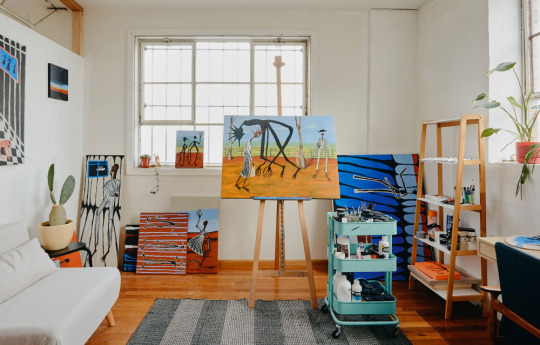
Mia’s new Brunswick studio is filled with light, and is the perfect space to continue on her growing portfolio of work. Photo – Amelia Stanwix for The Design Files.

A painting from her recent catalogue sits on the mantle. Photo – Amelia Stanwix for The Design Files.
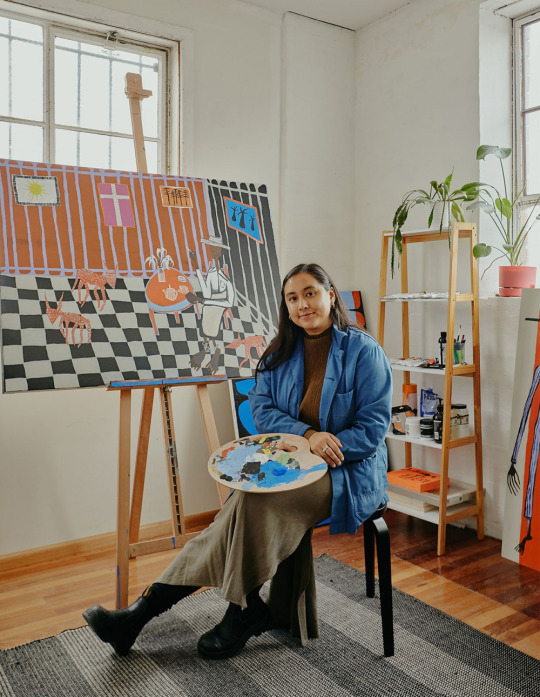
Butchalla-Burmese artist Mia Boe in her light-filled studio. Photo – Amelia Stanwix for The Design Files.
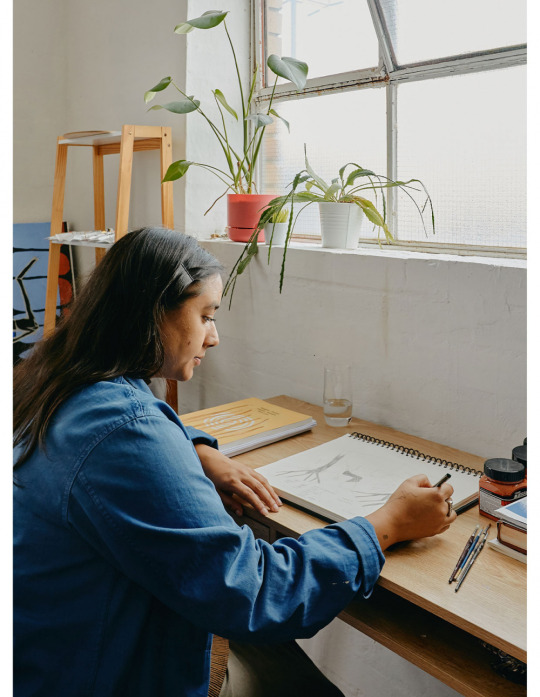
Mia paints full time and volunteers for The Torch in her spare time. Photo – Amelia Stanwix for The Design Files.
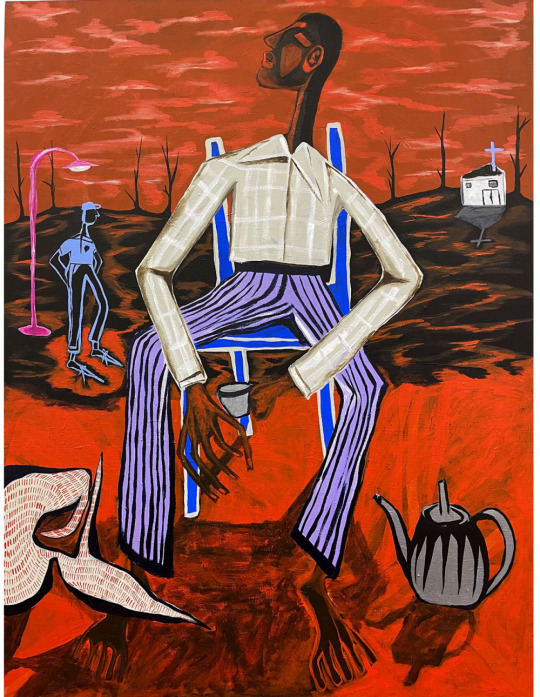
One of Mia’s works in progress.

Mia’s paintings are vibrant and narrative-driven, which means she does a lot of her own historical research. Photo – Amelia Stanwix for The Design Files.

Left: Mia is inspired by figures in art history like Albert Namatjira, Sidney Nolan and Russell Drysdale; and figures from history such as Eliza Fraser, Ned Kelly and the Queensland Native Police. Photo – Amelia Stanwix for The Design Files. Right: ‘Stripes 3’ by Mia Boe.
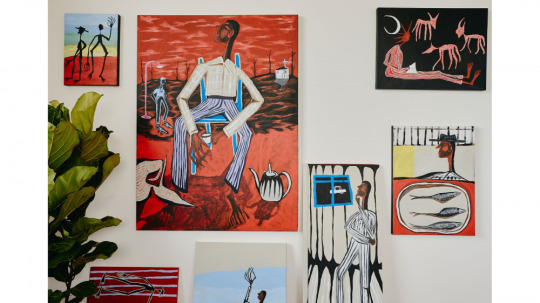
A selection of work Mia recently sold in her latest catalogue and has prepared for prize entries. Photo – Amelia Stanwix for The Design Files.
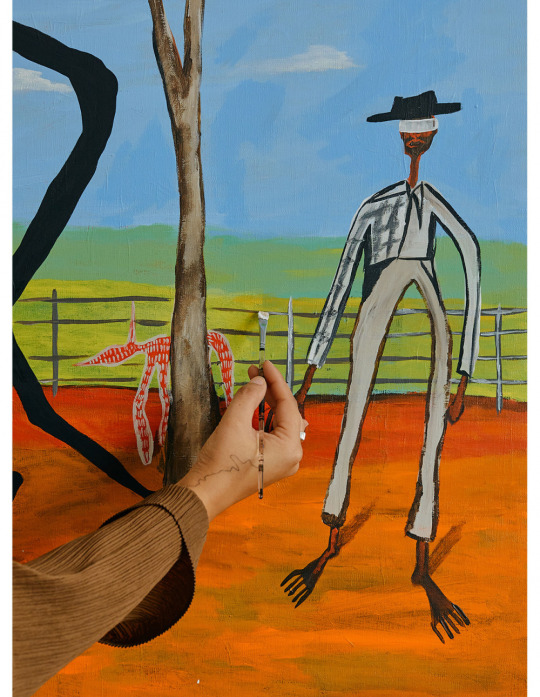
Her elongated, distended figures are always in the landscape and often accompanied by food, animals or spirits. Photo – Amelia Stanwix for The Design Files.
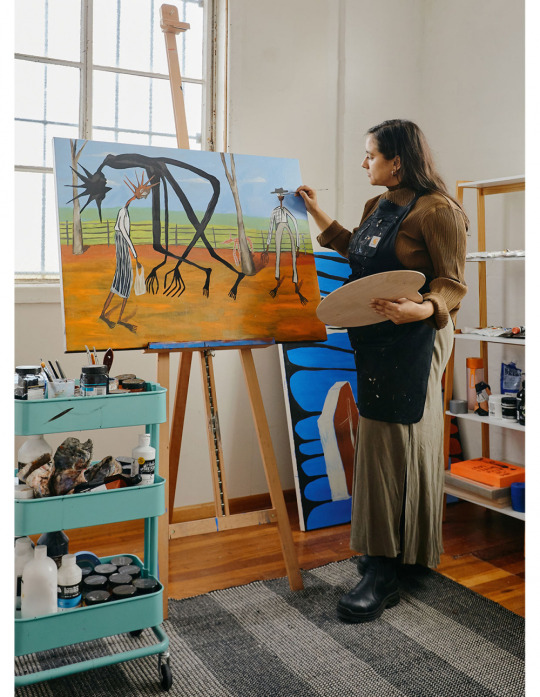
You can see the Sidney Nolan influence in this composition! Photo – Amelia Stanwix for The Design Files.

The historical and contemporaneous imprisonment of First Nations people is a continuous theme in Mia’s work. Patterns and vibrant colour create tension between the political context and the composition.
Watching Mia Boe’s rise to cult status is almost giving me whiplash. The Brisbane-raised, Melbourne-based artist has grown a dedicated following in the 18 months since she’s really begun concentrating on her painting – and it’s only going up. To give you an indication of just how devoted her audience are, her recent catalogue of nine paintings sold out in under two minutes.
Mia studied art history before last year, when Melbourne’s sweeping lockdowns gave her the time (and a good excuse!) to focus on her art. But it’s not just Instagram fans who are hot on her tail. With a residency at the Museum of Brisbane, commissions for Craft Victoria and Brisbane’s Institute of Modern Art, two group shows and a solo exhibition (titled Black Devil) at Open Space Collective under her belt since the beginning of 2020, it’s evident that Mia has well and truly caught the attention of the nation’s arts community.
But the institutions aren’t everything. When she’s not painting, Mia volunteers at The Torch – an organisation that aids First Nations prisoners and ex-prisoners with their art practices.
Art is the past, present and future for Mia – storytelling is her mode of being. Hear it in her own words.
How did you arrive at your current painting style? Has it evolved slowly over time or always been somewhat similar?
One clear continuity in my style has been that I tend to populate my landscapes with strangely elongated figures, whose bodies are also sometimes bloated and distended. I guess also that female figures in my work are representations, approximately, of myself, so a lot of my works could also function as self-portraits. But when I start a painting, I’m not always conscious of who the figure is, though if I’m painting black figures, they’re probably members of my family.
Also, I sometimes add larger figures with little detail, or floating in the landscape — these figures are representations of spirits. They represent family members that have died, and are a marker of the family that I will never get to know because of the repercussions of colonisation. I also try and experiment with colour: inspired by the ubiquitous blues of Robert Owen’s recent exhibition at Heide, I’ve recently been trying to control and limit my palette.
Do you use your art to connect with history or grapple with it?
Probably a bit of both. I’m especially interested in the histories of my family’s cultural heritages. My mum is a descendent of the Butchulla people, but she was only told by my grandmother that she was Aboriginal when she was in her teens (my grandmother was worried she’d have her children taken away from her if she was open about it). My Dad moved to Australia as a refugee from Burma when he was a young child.
My art practice has allowed me to research these twin histories, and to track the consequences of British colonisation in both Australia and Burma. (Burmese historian Thant Myint-U’s recent The Hidden History of Burma is an amazing book for people interested in learning more about Burma.) I hope soon to be able to spend some time looking at concrete connections between the colonial occupations of Australia and Burma. Empire, after all, makes the world smaller — it’s big project, I think, is to remake the margins in the image of the centre — so I’m sure there are some connections to be found (white officers, for instance, might have trained in Burma before coming to Australia, or vice versa).
Anyway, I definitely use my art to think through history: sometimes head-on, sometimes obliquely.
How do you involve historical references in your pieces?
I make sure that I’ve done proper research into a subject before making work about historical events. At the start of the year I showed my first exhibition in Brisbane. It was called Black Devil, and the works responded, from multiple angles, to the history of the Queensland Native Police: an exterminationist outfit which consisted of Aboriginal troopers led by white officers, and which aimed to wipe out resistance to colonisation.
The Native Police was active from 1848 to c. 1905 and were estimated to have killed over 44,000 Murris in those 50+ years. The fact that many of the massacres of Aboriginal people were carried out by Aboriginal troopers, who were themselves often kidnapped as boys, and barracked hundreds of kilometres from their kin and ancestral lands, pointed up for me the ongoing violence and infernal strategies of division which colonialism employs.
During research for this exhibition I found out that my ancestor, my great-great-grand uncle Wonamutta, a Butchulla man from K’gari (Fraser Island), was a trooper in the police force. Apart from his postings around the state, he was also seconded to the Victorian Police, where he helped to track down Ned Kelly (that’s where the exhibition’s title comes from — Kelly called the black trackers on his trail ‘black devils’).
Out of this discovery I got interested in Sidney Nolan. Two of Nolan’s most famous preoccupations were [Fraser Island’s namesake] Eliza Fraser and Ned Kelly. Nolan didn’t see these figures as related, and yet in an eerie way I think they were: Wonamutta, whose country was re-named by Europeans after Eliza Fraser, was also the man who caught Ned Kelly. So through thinking about this personal history, and the random but weird connections it disclosed, I came to envision my exhibition as also responding to Nolan’s own practice. It was a art show about history, but also about the history of art.
Do you have any key references or inspirations?
Some abiding influences for me have been Albert Namatjira and Russell Drysdale. Namatjira looms especially large: because of his tragic life story, his amazing colours. The William Dargie portrait of him which hangs in the Queensland Art Gallery, and the Noel Counihan linocut, which shows Namatjira crucified, are some really important images for me.
Drysdale matters for me because of the colours of his burnt-out backgrounds and those extraordinary gaunt figures idling about in them. His representations of Aboriginal people are very respectful and moving.
Other artists who are key points of departure for me are the contemporary South African artist Marlene Dumas, and Bill Traylor who was a self-taught artist born into slavery.
What does art-making mean to you?
On an individual level, my art allows me to recover and remake the cultural heritages which were stolen from me. And I hope in this process that I remind people (even as I learn myself) about the forgotten pasts which shape everyday life in the present.
Mia is represented by Sunday Salon. Learn more about her practice here. Mia’s next exhibition will be at Milani Gallery from 4th – 25th September.
2 notes
·
View notes
Link
North America’s fire season is waning, but here comes Australia, again. Bad stuff.
Excerpt from this story from EcoWatch:
The world's largest sand island has been on fire for the past six weeks due to a campfire, and Australia's firefighters have yet to prevent flames from destroying the fragile ecosystem.
The wildfires on Fraser Island, also called by its Indigenous name K'gari, have burned almost 200,000 acres of its unique habitat, including large sand dunes, swamps and rainforests. Fraser Island is near Brisbane on the northeastern coast, where dingos, swamp wallabies, sugar gliders and more than 60 reptile species call the island home. It was declared a UNESCO World Heritage site in 1992.
Several tourists visiting the island had to be evacuated as conditions worsened, Reuters reported.
The Guardian reported that crews are mainly addressing the problem from above, focusing on key ecological areas and sites that are important to the Butchulla Aboriginal people, who have called the island home for thousands of years.
However, fighting sand fires is difficult, Queensland Fire and Emergency Services assistant commissioner Gary McCormack told The Guardian. He explained how water quickly drained from the sand floor, even when dropped from above. Ground conditions weren't any better due to a lack of firebreaks.
"Unfortunately the current conditions are not conducive to extinguishment," McCormack said.
The fires are approaching the Valley of Giants, a tourist attraction known for its 1,000-year-old trees.
2 notes
·
View notes
Video
Lil progress vid trying to draw my handsome boyfriend and not offend him at the same time. 😂 . . . #draw #drawing #art #ArtistsonInstagram #artist #drawingsofinstagram #drawingoftheday #IndigenousArtist #torresstraitislander #torresstraitislanderart #firstnationsartist (at Butchulla Country) https://www.instagram.com/p/B9ysnZDJ4Hu/?igshid=12xi7s3id494l
#draw#drawing#art#artistsoninstagram#artist#drawingsofinstagram#drawingoftheday#indigenousartist#torresstraitislander#torresstraitislanderart#firstnationsartist
1 note
·
View note
Text
Sussex Down Under Day 7!
Upon landing at Fraser Island, the couple went their separate ways. Meg to their hotel to rest up, and Harry to his first engagement of the day. Side note - I hope we see Meg's dress again though!

Harry started his day with a traditional welcoming ceremony, and to unveil a a plauque for the Queen's Canopy. ‘Luckily we are highly skilled in unveiling plaques, it runs in the family.' K’Gari is what the Butchulla people call Fraser Island, it means Paradise. It’s also the only place on earth where a tall rainforest grows in the sand.


Let's just have a little Harry Appreciation post k?

He spent some time with local elders at Lake MacKenzie too learning about the cultural importance of the lake.

Reunited 😍 Meghan joined him for a public walkabout at the end of his day. They finished their day with a walk down the pier.


Meg is expected to be back to full engagements tomorrow, she feels good and well rested. Baby Sussex is running the show, and I'm sure Harry will make sure Meghan takes any more rest if needed.

#sussexdownunder#royalroundup#meghan markle#prince harry#duchess of sussex#duke of sussex#harry and meghan
127 notes
·
View notes
Photo




Harry with the Butchulla People on Fraser Island #royalvisitaustralia -- Rebecca English
29 notes
·
View notes
Text
Men and women carried initiation scars across their chests and painted their bodies with ochre. The men plucked their beards and stuck feathers in their hair. They were renowned fighters and musicians.

"Killing for Country: A Family History" - David Marr
#book quotes#killing for country#david marr#nonfiction#indigenous australians#aboriginal australian#initiation rites#scars#body paint#ochre#beard#feathers#butchulla#fighter#musician
1 note
·
View note
Quote
The Duke and Duchess of Sussex today carried out the following engagements on Fraser Island, Queensland, Australia.
.
His Royal Highness unveiled The Queen’s Commonwealth Canopy Plaque at Pile Valley and was received by the Hon Annastacia Palaszczuk, MP (Premier of Queensland).
.
The Duke of Sussex this afternoon visited Lake McKenzie and met Indigenous Elders of the Butchulla People.
.
His Royal Highness afterwards visited McKenzie’s Jetty and met Indigenous Land and Sea Rangers and Queensland Parks and Wildlife Service Rangers.
.
The Duke and Duchess of Sussex later visited Kingfisher Bay Jetty.
Court Circular | 22 October, 2018
15 notes
·
View notes
Note
in the striped beach wrap you can actually see her underpants. The DM has pics. Where she is holding the teddy bears. Unbelievable.
https://www.dailymail.co.uk/news/article-6301505/Meghan-Harry-spotted-boarding-flight-Fraser-Island-whirlwind-Australian-tour-continues.html
It’s amazing. The Butchulla reception was awesome and it was totally overshadowed by Meg’s boardwalk stroll.
13 notes
·
View notes
Text
The Duke and Duchess of Sussex's visit to Australia, Fiji, Tonga and New Zealand
Their Royal Highnesses The Duke and Duchess of Sussex will undertake an official visit to Australia, Fiji, the Kingdom of Tonga and New Zealand between Tuesday 16th and Wednesday 31st October.
Their Royal Highnesses have been invited to visit the Commonwealth Realms of Australia and New Zealand by the countries' respective Governments, and Fiji and Tonga at the request of the Foreign and Commonwealth Office. This will be The Duke and Duchess's first joint visit to these four countries.
Across this sixteen day tour, Their Royal Highnesses' programme will focus on youth leadership, and projects being undertaken by young people to address the social, economic, and environmental challenges of the region. The Duke is particularly keen to highlight these youth-led initiatives in his new role as Commonwealth Youth Ambassador, and to shine a light on the work and aspirations of young people across the Commonwealth.
The visit will also concentrate on environmental and conservation efforts, from engaging the local community in forest protection schemes in Colo-i-Suva, to the promotion of sustainable tourism on Fraser Island. The Duke and Duchess will dedicate a number of projects to The Queen's Commonwealth Canopy in each country, learning more about local conservation initiatives, whilst visiting some of the region's most beautiful landscapes.
A major focus for Their Royal Highnesses will also be the Invictus Games Sydney 2018. The Duke and Duchess are excited to see Sydney fully embrace the Invictus spirit, and to support the competitors as they compete across a range of sports at some of the city's most iconic venues. This year's Games will emphasise the integral role played by servicemen and women's family and friends, and Their Royal Highnesses will spend time with a number of the competitors' supporters as they cheer them on from the side-lines.
There is a long history of friendship between The Royal Family and Australia, Fiji, Tonga and New Zealand, and their links with the UK are extensive. The Duke and Duchess are very much looking forward to experiencing the unique cultures and customs of these four Commonwealth countries, and have asked that this tour allow them opportunities to meet as many Australians, Fijians, Tongans and New Zealanders as possible. Together they look forward to building an enduring relationship with the people of the region.
The first day of the tour will begin in Sydney at Admiralty House, the official Sydney residence of the Governor-General of Australia, His Excellency General the Honourable Sir Peter Cosgrove and Lady Cosgrove, who will welcome them to his home which offers spectacular views across Sydney Harbour. Representatives from each of the eighteen countries who are participating in the Invictus Games Sydney 2018 will be present.
The Duke and Duchess will then travel to Taronga Zoo to officially open the new Taronga Institute of Science and Learning. During this visit, which will also be attended by the New South Wales (NSW) Premier, The Duke and Duchess will meet two koalas and their joeys that are part of the Zoo’s breeding programme, and visit the laboratory to meet female conservation scientists who are working on efforts to reduce illegal wildlife trafficking.
To depart the Zoo, The Duke and Duchess will travel by vessel across Sydney Harbour to the Sydney Opera House. Once inside, Their Royal Highnesses will view a rehearsal of Spirit 2018 by the Bangarra Dance Theatre, an internationally acclaimed Aboriginal and Torres Strait Islander modern dance company. Upon departure, walking along the Opera House forecourt, The Duke and Duchess will have an opportunity to meet members of the public.
The first day of the visit will conclude with a Reception hosted by the Governor-General at Admiralty House, to be attended by Australians from a broad range of sectors including charity and community, business and industry, arts and culture, sport and entertainment.
The following morning, Their Royal Highnesses will fly to the town of Dubbo, situated on the Macquarie River, 300 kilometres northwest of Sydney. On arrival in Dubbo, The Duke and Duchess will visit the Royal Flying Doctor Service to learn more about the life-saving role the aviation service provides for people living in rural and regional areas.
With most of the state of New South Wales suffering from drought, Their Royal Highnesses will see first-hand the hardships local farmers are facing by visiting a local property. The Duke and Duchess will then travel to Victoria Park to join people from Dubbo and surrounding areas at a picnic in the park to celebrate community spirit within the region. Members of the public are invited to attend, and His Royal Highness will give an address.
In the afternoon, The Duke and Duchess will visit a local school working to improve the education outcomes of young Aboriginal and Torres Strait Islanders. Students will open up their classrooms to present their work and participate in a session of netball and touch football drills on the school oval, highlighting the importance of sport in education.
On Thursday 18th October, Their Royal Highnesses will fly to Melbourne where the day will begin with a short walk to Government House, meeting members of the public along the way, before attending an official Reception at Government House. A diverse group of young Victorian leaders and community members will attend the Reception, including Queen's Young Leader Hunter Johnson from The Man Cave. A demonstration of various sporting activities will take place in the grounds, with ambassadors from the This Girl Can campaign.
Following the Reception at Government House, The Duke and Duchess will visit a social enterprise café which offers leadership, mentoring and training programmes for young Aboriginal people.
In the afternoon, Their Royal Highnesses will visit a primary school to meet students who are involved in sustainability programmes. Upon departure from the school, The Duke and Duchess will travel on an iconic Melbourne tram to South Melbourne beach, where they will meet volunteers from a local beach patrol programme. Here Their Royal Highnesses will learn about efforts to keep Port Phillip Bay beaches and foreshores clear of litter to reduce the negative impact on the marine environment.
Day four of the visit, Friday 19th October, will take place in Sydney. In the morning, Their Royal Highnesses will visit Bondi Beach, one of Australia’s most famous landmarks. The Duke and Duchess will meet a local surfing community group, known as OneWave, raising awareness for mental health and wellbeing in a fun and engaging way. Their Royal Highnesses will take part in the "Fluro Friday" session, where people of all ages share their experiences of mental health issues, and will have the opportunity to interact with others enjoying yoga and surfing. Before departing, The Duke and Duchess will have an opportunity to meet members of the public gathered on the beach.
Later that morning, Their Royal Highness will take part in a youth advocate programme that aims to unite and inspire young people to be advocates for cohesion and inclusion in their communities. The Duke and Duchess will also engage with students as they discuss issues including social justice and youth empowerment.
Following this event, accompanied by the Prime Minister the Honourable Scott Morrison MP, and Invictus Games competitors, The Duke will climb the Sydney Harbour Bridge to officially raise the Invictus Flag, marking the arrival of the Invictus Games to Sydney.
Their Royal Highnesses will conclude the day with calls on the Leader of the Opposition at Admiralty House, and the Prime Minister at Kirribilli House.
On Saturday 20th October, The Duke and Duchess will travel by boat to attend the Invictus Games Sydney 2018 Jaguar Land Rover Driving Challenge on Cockatoo Island. In the evening, Their Royal Highnesses will attend a Reception hosted by the NSW Premier, The Honourable Gladys Berejiklian MP, inside the Opera House, prior to attending the Invictus Games Sydney 2018 Opening Ceremony where The Duke of Sussex will give an address.
On day six, Sunday 21st October, Their Royal Highnesses will watch some elements of the Invictus Games cycling and sailing, and attend a lunchtime Reception hosted by the Prime Minister, with Invictus Games competitors and representatives from the community in the city’s central parkland, The Domain.
The following day, Monday 22nd October, Their Royal Highnesses will travel to Queensland’s Fraser Island, or K’gari as it is known by the Traditional Owners the Butchulla people, as part of the dedication of the site to the Queen's Commonwealth Canopy (QCC).
Fraser Island is the largest sand island in the world, and has a total of 206,970 acres of protected forest. Among its many striking features, the Island is characterised by its long beaches, tall rainforest, coastal heaths, freshwater lakes and ever-evolving sand dunes.
In pristine rainforest, Their Royal Highnesses will be met upon arrival by the Traditional Owners of K'gari, the Butchulla People and the Premier of Queensland. The Duke and Duchess will take part in a traditional Welcome to Country Smoking Ceremony and unveil a plaque for the dedication of the Forests of K’gari to the QCC. Traditional Owners from Bulburin National Park, the second QCC dedication site in Queensland, will also be present. Fraser Island rainforest is home to the Island’s satinay trees which, known for their hardiness in water, were used to build the London docks in the 1930s.
The Duke and Duchess will then visit one of Fraser Island’s iconic lakes to meet with local elders and national park rangers to learn about the Island’s natural beauty, rich history, biodiversity and cultural significance. From here, Their Royal Highnesses will travel to the beach to learn about the history in the Island’s logging trade, as well as its use as a training base for the Australian Z Special Unit during World War II.
Their Royal Highnesses will then travel to Kingfisher Bay by boat, where the visit will conclude with a walk along the picturesque Kingfisher Bay Jetty.
The following day, The Duke and Duchess will travel by charter flight to Fiji's capital of Suva, where they will embark on a three-day programme, experiencing the rich Fijian culture and generous hospitality.
On arrival on Tuesday 23rd October, Their Royal Highnesses will be greeted by a Guard of Honour at the airport, before calling on His Excellency The President of Fiji at Borron House. The Duke and Duchess will then attend an official welcome ceremony in the city centre's Albert Park. The ceremony, known as the Veirqaraqaravi Vakavanua, embodies Fijian cultural identity and heritage, and will mirror in format that of the one attended by The Queen and The Duke of Edinburgh in 1953. It will involve a number of traditional elements of Fijian culture, including dance performances, the presentation of the Tabua, and a Kava ceremony. Members of the public from across Suva will be invited to attend.
From there, The Duke and Duchess will leave Albert Park for the Grand Pacific Hotel to attend a Reception and a State Dinner hosted by The President of Fiji, at which The Duke will speak.
The following morning, His Royal Highness will lay a wreath at the Fiji War Memorial, and meet a number of Fijian war veterans, some of whom served with the British Armed Forces. Links between the British Military and Fiji continue to this day with more than 1250 Fijians currently serving in the British Army. Their Royal Highnesses will then visit the University of the South Pacific campus in Suva, where they will observe a cultural performance on the effects of climate change, before meeting students studying subjects from agriculture to women’s development. The event will be streamed to a number of the university's campuses throughout the Pacific region. The Duke will make a short speech in his capacity as Commonwealth Youth Ambassador, and The Duchess will say a few words.
From here, Their Royal Highnesses' programme will split – The Duke will travel to Colo-i-Suva Forest Park, and The Duchess to the British High Commissioner’s Residence. Colo-i-Suva is an indigenous forest site housing many flora and fauna native to Fiji, and species including the Fiji Tree Frog. It is also Fiji's dedication to The Queen's Commonwealth Canopy. Before unveiling a plaque to mark its dedication and planting an endangered native tree, His Royal Highness will meet with school children, student conservators, representatives from sustainable tourism industries, and local landowners and villagers to see how the rainforest impacts upon their education and livelihoods.
Meanwhile, The Duchess will attend a morning tea at the British High Commissioner’s Residence to showcase women's organisations which operate throughout Fiji. In particular, Her Royal Highness will hear more about a UN Women's project, 'Markets for Change', which promotes women's empowerment in marketplaces throughout the Pacific. The Duchess will then travel to Suva Market to meet some of the female vendors who have become empowered through the project.
On the morning of Thursday 25th October, The Duke and Duchess will travel to the city of Nadi in Western Fiji, where they will attend a special event at Nadi Airport. After an official welcome ceremony, The Duke and Duchess will unveil a new statue commemorating Sergeant Talaiasi Labalaba, a British-Fijian soldier who lost his life in the 1972 Battle of Mirbat. The event will be attended by the President of Fiji, and senior representatives from government and the Armed Forces.
From Nadi Airport, Their Royal Highnesses will take a chartered flight to Tonga, where they will be met at Fua'amotu Airport by Her Royal Highness The Princess Angelika Latufuipeka. That evening, The Duke and Duchess will visit Consular House in central Nuku'alofa for a private audience with His Majesty King Tupou VI and Queen Nanasipauʻu, to be followed by an official reception and dinner, and traditional Tongan entertainment.
The following morning, The Duke and Duchess will visit the St George Building for a call on the Prime Minister S. Akilisi Pohiva and members of the cabinet. From there, Their Royal Highnesses will attend an exhibition with The Princess Angelika at the Faonelua Centre, celebrating Tongan handicrafts and products, including traditional mats and 'tapa' cloth. Their Royal Highnesses will also have the opportunity to meet local Tongan traders and craftsmen.
The Duke and Duchess will then travel to Tupou College, which is the oldest secondary school in the Pacific, founded by a British missionary in 1866. Their Royal Highnesses will dedicate two forest reserves at the school's on-site forest, the Toloa Forest Reserve, the last remaining forest area on Tonga’s main island of Tongatabu, and the Eua National Park Forest Reserve, located at the Island of Eua – to The Queen's Commonwealth Canopy. The Tupou College Boys' will perform traditional Tongan music to commemorate the event.
From Tupou College, The Duke and Duchess will travel to The Royal Palace for an official farewell with The King before departing for Sydney.
That evening in Sydney, Their Royal Highnesses will attend the Australian Geographic Society Awards, an annual gathering of Australia's brightest and best in exploration, science and conservation. Their Royal Highnesses will present youth awards to honour the highest achievements in conservation and adventure, and The Duke will give an address.
The last day of the Australian programme falls on the final day of the Invictus Games. Their Royal Highnesses will spend the afternoon at the wheelchair basketball finals at the Quay Centre, before attending the Closing Ceremony that evening at Qudos Bank Arena. The event, at which both The Duke and Duchess will speak, promises to be a celebration of the outstanding achievements and inspiring spirit of the Invictus Games competitors.
The following morning, Sunday 28th October, The Duke and Duchess will depart on a Royal New Zealand AirForce flight for Wellington. Their Royal Highnesses will travel on the same aircraft as a number of the New Zealand Invictus Games competitors, and on arrival, will be met off the plane together by the Prime Minister Jacinda Ardern.
From the airport, Their Royal Highnesses will attend the traditional welcome ceremony on the lawns of Government House – the residence of the Governor-General to New Zealand Dame Patsy Reddy. Their Royal Highnesses will be invited to hongi with the Governor-General’s Kuia and Kaumātua (Māori elders), before the pōwhiri, which includes a haka performed by members of the New Zealand Defence Force. The ceremony will also include a 21-gun salute, and will be attended by school children.
Their Royal Highnesses will then travel to the Pukeahu National War Memorial Park. Here, they will lay a wreath at the Tomb of the Unknown Warrior, and will visit the newly unveiled UK War Memorial – whose design takes the form of two of the United Kingdom and New Zealand’s most iconic trees – the Royal Oak and a Pōhutakawa. This engagement will be followed by a public walkabout in the Memorial Park.
That evening, The Duke and Duchess will receive official calls from the Prime Minister and Leader of the Opposition at Government House, before attending a reception hosted by the Governor General celebrating the 125th anniversary of women’s suffrage in New Zealand.
The next morning, The Duke and Duchess will visit one of Wellington’s most iconic cafes. Their Royal Highnesses will meet young people from a number of mental health projects operating in New Zealand offering support to other young people through helplines, social media, websites and school-based programmes.
From Wellington, The Duke and Duchess will travel to Abel Tasman National Park, which sits at the north-Eastern tip of the South Island, and is an area famed for its golden beaches and native bush walks. Their Royal Highnesses will be greeted by a traditional welcome ceremony on arrival, before embarking on a trail walk with one of the park’s rangers to learn more about the history of the forest and the environmental challenges of protecting the park’s habitat. Before departing, The Duke and Duchess will join some of the park’s young ambassadors and local school children at a barbeque lunch and for a tree planting.
That evening back in Wellington, Their Royal Highnesses will visit Courtenay Creative for an event celebrating the city’s thriving creative arts scene. Courtney Creative runs programmes to give young people the tools and experience to excel in the film industry, and The Duke and Duchess will meet a number of young creatives demonstrating their skills in props, make-up, and costume.
The following day, Their Royal Highnesses will travel to Auckland, where they will firstly visit the North Shore to dedicate a 20 hectare area of native bush to The Queen’s Commonwealth Canopy. After unveiling the plaque, The Duke and Duchess will hear more about the ecological importance of the native bush, before joining children from the 'Trees in Survival' group in a ‘welly-wanging’ contest.
Their Royal Highnesses will then join the Prime Minister to visit Pillars, a charity operating across New Zealand that supports children who have a parent in prison through the provision of special mentoring schemes. As a wedding present to The Duke and Duchess, the Government of New Zealand gifted $5000 dollars to Pillars, and Their Royal Highnesses will have the opportunity to meet some of the children who have directly benefitted from this funding.
Later that afternoon, The Duke and Duchess will have the opportunity to meet the people of Auckland on the Viaduct Harbour, before attending a Reception hosted by the Prime Minister at the Auckland War Memorial Museum. This reception will include cultural performances and entertainment by members of the Pasifika community living in Auckland. The guests will be predominantly young people in the 17 to 25-year age group who are making significant contributions to the wellbeing of their communities, representing the future of New Zealand.
The final day of Their Royal Highnesses’ tour will take place in Rotorua, a town set on Lake Rotorua, renowned for its geothermal activity and Maori culture. The Duke and Duchess will firstly visit Te Papaiouru Marae, for a formal pōwhiri and luncheon in Their Royal Highnesses’ honour.
Next, The Duke and Duchess will head to Rainbow Springs to learn more about the centre’s kiwi breeding programme. Kiwi, which are New Zealand’s national bird, have become increasingly endangered in recent years, and Their Royal Highnesses will meet conservationists working to protect the species. They will also have the opportunity to name two young kiwi chicks at Rainbow Springs.
Later that afternoon, The Duke and Duchess will head into the city for the chance to meet members of the public gathered there. They will then travel to Redwoods Treewalk Rotorua. The treewalk is a 700m-long walkway of suspension bridges between 117-year-old Redwood trees. The forest is also the home to a thriving mountain biking community that draws people of all ages to the Redwoods. The Duke and Duchess will learn more about the forest’s history as they take on the tree walk, and will then meet invited representatives of the local biking community under the forest canopy.
Their Royal Highnesses will return to Auckland that evening, before departing for London the following day.
#Meghan Markle#Prince Harry#celebrities#british royal family#Duke of Sussex#Duchess of Sussex#royal tour
13 notes
·
View notes